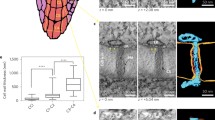Summary
A study of the structure and arrangement of nuclear pores has been made in a number of species. In Selaginella kraussiana, the species investigated most extensively, the pores were arranged in a manner consistent with the view that each pore was located at the centre of an hexagonal structure lying on the nuclear surface. The significance of this arrangement and some evidence relating to the structure of the pores is discussed. In other species examined, no evidence of a regular arrangement of the pores was observed.
Similar content being viewed by others
References
Afzelius, B. A.: The ultrastructure of the nuclear membrane of the sea urchin oöcyte as studied with the electron microscope. Exp. Cell Res. 8, 147–158 (1955).
Bajer, A., Molè-Bajer, J.: Formation of spindle fibres, kinetochore orientation and behaviour of the nuclear envelope during mitosis in endosperm. Chromosoma (Berl.) 27, 448–484 (1969).
Branton, D., Moor, H.: Fine structure in freeze-etched Allium cepa (L.) root tips. J. Ultrastruct. Res. 11, 401–411 (1964).
Bünning, E.: Morphogenesis in plants. Survey of Biol. Progr. 2, 105–140 (1952).
Callan, H. G., Tomlin, S. G.: Experimental studies on amphibian oöcyte nuclei. I. Investigation of the structure of the nuclear membrane by means of the electron microscope. Proc. Roy. Soc. B 137, 367–378 (1950).
Chafe, S. C.: The ultrastructure of collenchyma and some observations on the epidermis. Doct. dissert., La Trobe University, Melbourne, Australia (1970).
Da Silva, P. P., Branton, D.: Membrane splitting in freeze-etching. J. Cell Biol. 45, 598–605 (1970).
Franke, W. W.: Isolated nuclear membranes. J. Cell Biol. 31, 619–623 (1966).
—: Zur Feinstruktur isolierter Kernmembranen aus tierischen Zellen. Z. Zellforsch. 80, 585–593 (1967).
Griffiths, D. J.: Light induced cell division in Chlorella vulgaris (Beijerinck) var. Emerson. Ann. Bot., N. S. 25, 85–93 (1961).
Lawford, G. R., Satowski, P., Schachter, H.: Use of ribonuclease inhibitor from rat liver supernatant fraction in the preparation of polyribosome-like particles from isolated rat liver nucleii. J. molec. Biol. 23, 81–87 (1967).
McCarty, K. S., Parsons, J. T., Carter, W. A., Laszlo, J.: Protein synthetic capacities of liver nuclear subfractions. J. biol. Chem. 241, 5489–5499 (1966).
Mepham, R. H., Lane, G. R.: Nucleopores and polyribosome formation. Nature (Lond.) 221, 288–289 (1969).
Merriam, R. W.: Some dynamic aspects of the nuclear envelope. J. Cell Biol. 12, 79–90 (1962).
Mirsky, A. E., Osawa, S.: The interphase nucleus. In: The cell, vol. 2, pp. 193–290, J. Brachet, A. E. Mirsky, eds. New York: Acad. Press 1961.
Moor, H.: Die Gefrier-Fixation lebender Zellen und ihre Anwendung in der Elektronenmikroskonie. Z. Zellforsch. 62, 546–580 (1964).
—, Mühlethaler, K.: Fine structure in frozen-etched yeast cells. J. Cell Biol. 17, 609–628 (1963).
Northcote, D. H., Lewis, D. R.: Freeze-etched surfaces of membranes and organelles in the cells of pea root tips. J. Cell Sci. 3, 199–206 (1968).
O'Brien, T. P.: Observations on the fine structure of the oat coleoptile. I. The epidermal cells of the extreme apex. Protoplasma (Wien) 63, 385–416 (1967).
Pappas, G. D.: The fine structure of the nuclear envelope of Amoeba proteus. J. biophys. biochem. Cytol. 2, No. 4, Suppl. 431–434 (1956).
Roberts, K., Northcote, D. H.: Structure of the nuclear pore in higher plants. Nature (Lond.) 228, 385–386 (1970).
Robertson, J. D.: The origin of the membrane concept. Protoplasma (Wien) 63, 218–245 (1967).
Smith, S. J., Adams, H. R., Smetana, K., Busch, H.: Isolation of the outer layer of the nuclear envelope. Composition of the RNA. Exp. Cell Res. 55, 185–197 (1969).
Spurr, A. R.: A low-viscosity epoxy resin embedding medium for electron microscopy. J. Ultrastruct. Res. 26, 31–43 (1969).
Stevens, B. J., Swift, H.: RNA transport from nucleus to cytoplasm in Chironomus salivary glands. J. Cell Biol. 31, 55–77 (1966).
Threadgold, L. T.: The ultrastructure of the animal cell. London: Pergamon Press 1967.
Wischnitzer, S.: An electron microscopy study of the nuclear envelope of amphibian oöcytes. J. Ultrastruct. Res. 1, 201–222 (1958).
Zetterberg, A.: Nuclear and cytoplasmic growth during interphase in mammalian cells. Advanc. Cell Biol. 1, 211–232 (1970).
Author information
Authors and Affiliations
Rights and permissions
About this article
Cite this article
Thair, B.W., Wardrop, A.B. The structure and arrangement of nuclear pores in plant cells. Planta 100, 1–17 (1971). https://doi.org/10.1007/BF00386883
Received:
Issue Date:
DOI: https://doi.org/10.1007/BF00386883




